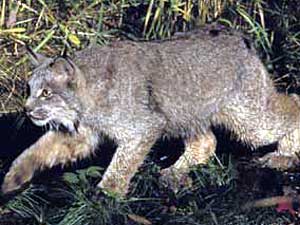|
Photos
Resources
Your Voice
|
The missing lynx
April 24, 2003
 |
| Canada lynx are a "medium" sized cat, the size of a cocker spaniel. They have tufted ears, a bobbed tail, and large "snowshoe" feet. (Photo by Erwin Bauer, U.S. Fish and Wildlife Service) |
Isabella, Minn. — Lynx are a northern forest cat, with tufted ears, a stubby tail, and big snowshoe feet. They're about the size of a cocker spaniel. Lynx are loners and range a huge territory. They seem to follow snowshoe hare, and recently, the Superior National Forest has been jumping with hares.
"It doesn't matter where snowshoe hares are," according to University of Minnesota researcher Chris Burdette. "If they're there, that's where cats are going to be."
 | |||
As Burdette explains, "There's a lot of snowshoe hares in this part of the area, and up to ninety percent of a lynx's diet is snowshoe hares."
Hare populations boom and bust in about seven-year cycles. But in recent population booms, the lynx were missing. By the mid-1990s, lynx were considered gone from Minnesota. Until now. Three years ago, the cats were spotted again -- on the Sawbill Trail up the hill from the North Shore, near Isabella and near Ely.
Burdette has just begun to count and track northeast Minnesota's lynx. Two cats have been fitted with radio collars. It's not yet clear how many others are wandering the forest. And Burdette says, lynx do wander.
"It's very likely that the majority of these animals migrated from Canada," Burdette speculates. "These animals innately want to disperse long distances."
Burdette was checking his traps recently, marching through dense balsam pine and the last remnants of spring snow.
 | |||
His lynx traps are chicken wire boxes, the size of a big dog house, with a bit of hare or beaver in the back and a door on the front poised to slap shut. But on this day, there were no lynx to be found.
"Obviously nothing's been in there," he notes. "This one looks clear." He rearranges a few pine boughs over the chicken wire frame.
Lynx are found across much of Canada and Alaska. Their historic range includes Maine, the western mountains, and Lake Superior forests. Lynx were added to the list of threatened species three years ago. An environmental group sued the U.S. Fish and Wildlife service, saying the agency's recovery plans overlooked lynx populations in Minnesota, Maine and the southern Rockies.
Mike Leahy, counsel for Defenders of Wildlife, says it's clear there are lynx in Minnesota.
"The Minnesota Department of Natural Resources had for a long time vehemently denied that there could possibly be more than one or two lynx in the entire state," says Leahy. "And, they found indeed, there's a resident population of lynx in Minnesota."
Lynx aren't entirely welcomed. Some residents worry that rules protecting the threatened species might stop timber sales, or close roads and recreation trails. They remember the Pacific Northwest, where logging was stopped for spotted owls. But that won't happen for lynx, according to Superior National Forest Biologist Ed Lindquist.
 | |||
"It's certainly not a fourlegged spotted owl," Lindquist says. "It really likes regenerating forest -- dense regenerating forest, that provides good snowshoe hare habitat."
And regenerating forest is what you get after harvesting timber. New aspen growth attracts hares. Lynx also need older growth nearby for shelter.
Chris Burdette's study will help create a lynx recovery plan. But he says recovery -- actually getting the cat off federal protection -- isn't even on the horizon.
"No where near it," he says. "Very preliminary stages. We're just in the data collection stages now, so we can put some kind of scientific thoughts into the process of managing this species."
There's little known about the elusive cat or it's prey. Understanding snowshoe hares will help researchers understand the lynx.
"Are they going to be here in three years? Are they going to be here in five years, or whatever? That's a very open question," Burdette says.
Burdette will trap lynx until bears begin raiding the bait in his box traps. Then he'll radio track collared lynx and monitor hare feeding areas for signs of lynx. The lynx study is funded for three years, but it might take 10 to begin understanding this rare cat.
|
News Headlines
|
Related Subjects
|
